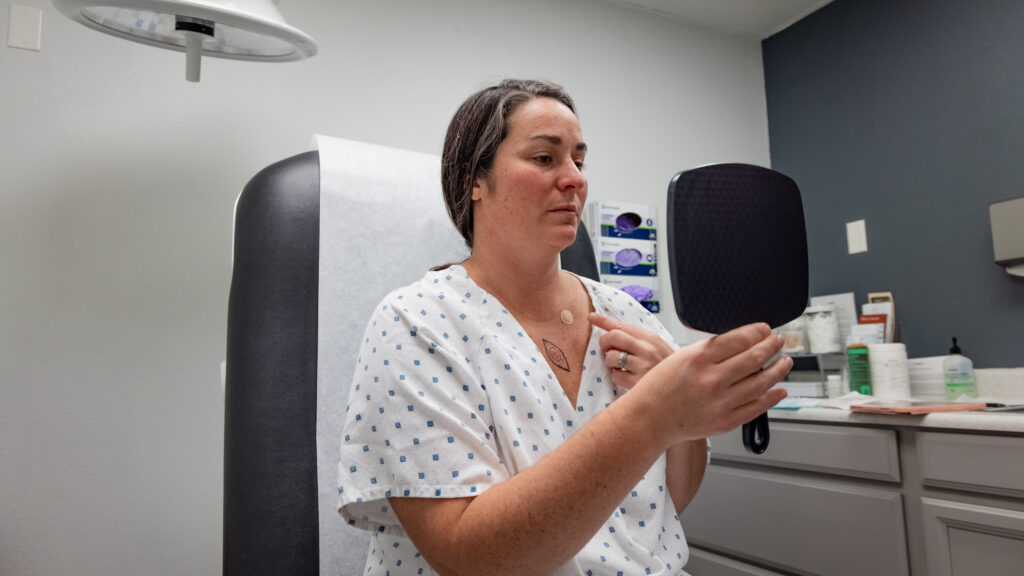Tattoos are often seen as powerful expressions of individuality. In the medical world, however, they can serve as unwanted reminders of a difficult past.
For cancer patients who require radiation therapy, permanent tattoos have long been necessary to help doctors accurately target and deliver treatment. While seemingly insignificant, these permanent spots can remind many patients of their cancer journey every time they see themselves in the mirror. It’s time to put ink and needles in the rear view, because radiotherapy tattoos do more than mar the skin; they can mar the survivorship mindset.
advertisement
The experience of breast cancer patients highlights the emotional toll these tattoos can take. Traditionally, these patients receive between four and a dozen freckle-size tattoos to guide radiation treatment.
“Women suffer not only by the knowledge of the disease, but they are also marked with reminders of the experience by an increasingly outdated positioning technique,” one paper explains. Tattoos can help radiation therapists with positioning but are a “constant reminder of this disease and the patient’s treatment and fight against it.”
This isn’t true for everyone: Some see their tattoos as a badge of resilience, even expanding them into larger, meaningful designs. In a U.K.-based survey of breast cancer survivors, 59% of respondents who could see the tattoos on their breastbone after cancer treatment were “never bothered” by them.
advertisement
However, the same survey noted that 27% of the participants viewed the tattoos negatively, and 14% of those surveyed said the tattoos affected their clothing choices. Other reports are even more striking; a survey of young women diagnosed with breast cancer before age 40 found that approximately 60% of the women had “negative” or “very negative” feelings toward receiving a tattoo as part of treatment, with 78% of interviewed women stating they would choose treatment that avoided tattoos and/or marks, even if additional efforts were required, such as additional costs, extra distance, or time for travel.
Beyond the emotional impact, tattoos can also lead to physical complications. Some patients experience allergic reactions, dermatoses, keloids, infection, and even permanent scarring. Tattoo removal can be an option: The American Society for Laser Medicine and Surgery has even launched a program in which volunteers remove radiotherapy tattoos free of charge for patients who have undergone radiation treatment for any type of cancer, highlighting the need for a more individualized approach.
But increasingly, there is an alternative to tattooing — most notably, surface-guided radiation therapy (SGRT).
SGRT utilizes a three-dimensional camera to help accurately track body movements in real-time, including subtle shifts like breathing movements, no tattooing required. This allows for incredibly precise treatment delivery, pausing treatments automatically if the patient moves beyond a set threshold.
Our health system began phasing out radiotherapy tattoos in 2019. While breast cancer patients were the first group for us to treat tattoo/marker free, we have widened our vision to include other anatomical sites after witnessing firsthand its positive impact. Some patients come in and are pleasantly surprised that they won’t need the tattoo marks that their parents or older siblings received. Others, including men with prostate cancer, have purposely sought out facilities to avoid tattoo marks.
advertisement
Increased familiarity with the technology has allowed us to omit marks on the head, neck, chest, back, abdomen, pelvis, or extremities. This allows patients the freedom to choose their swimwear to evening wear to everything in-between without worrying about covering unwanted tattoos. Kids with childhood cancers don’t experience additional discomfort, nor do they have permanent, involuntary body modifications that follow them into adulthood.
More widespread adoption of SGRT is not without its challenges. The technology requires a capital financial investment and specialized training for health care professionals as well as a fundamental shift in mindset.
Removing tattoos also improves clinic safety for both patients and staff, eliminating that risk of accidental needle sticks. Sharps containers are emptied less frequently, tattooing devices are no longer purchased, resulting in gradual cost savings for the department. We believe the long-term benefits for patients and staff, both physically and emotionally, far outweigh the initial costs.
Others are starting to catch on. While we were the first in the New York metro area to become completely tattoo/mark free, there are a growing number of facilities throughout the country and world that now offer the same.
As health care providers, our commitment to patient-centered care compels us to constantly seek ways to improve the cancer treatment experience. By embracing innovation and challenging outdated practices, we are creating a new paradigm for radiation therapy, one where technology and compassion converge to provide the highest quality care and quality of life.
William Chun-Ying Chen, M.D., is vice chair for radiation medicine quality and safety at Northwell Health and assistant professor at the Donald and Barbara Zucker School of Medicine at Hofstra/Northwell. Louis Potters, M.D., is deputy physician-in-chief of the Northwell Cancer Institute, and professor and chair of the department of radiation medicine at the Donald and Barbara Zucker School of Medicine at Hofstra/Northwell.
advertisement

